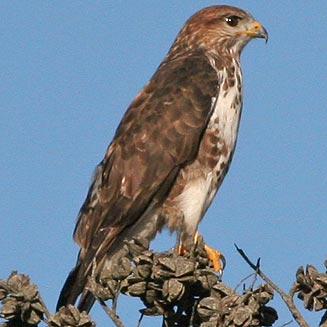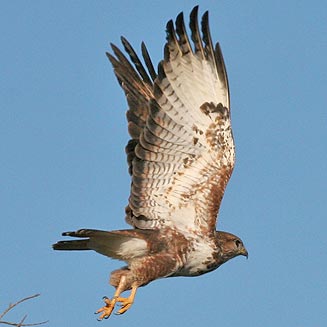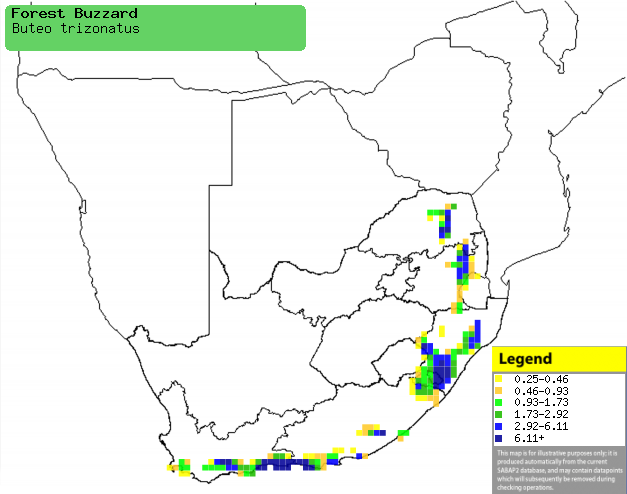|
Buteo trizonatus (Forest buzzard)
Bosjakkalsvoėl [Afrikaans]; Kaapse bergbuizerd
[Dutch]; Buse forestičre [French]; Bergbussard [German];
Bśtio-da-floresta [Portuguese]
Life
> Eukaryotes >
Opisthokonta
> Metazoa (animals) >
Bilateria >
Deuterostomia > Chordata >
Craniata > Vertebrata (vertebrates) > Gnathostomata (jawed
vertebrates) > Teleostomi (teleost fish) > Osteichthyes (bony fish) > Class:
Sarcopterygii (lobe-finned
fish) > Stegocephalia (terrestrial
vertebrates) > Tetrapoda
(four-legged vertebrates) > Reptiliomorpha > Amniota >
Reptilia (reptiles) >
Romeriida > Diapsida > Archosauromorpha > Archosauria >
Dinosauria
(dinosaurs) > Saurischia > Theropoda (bipedal predatory dinosaurs) >
Coelurosauria > Maniraptora >
Aves (birds) > Order:
Falconiformes
> Family:
Accipitridae
> Genus:
Buteo
 |
 |
| Forest buzzard, Nature's Valley,
Western Cape, South Africa. [photo
Duncan Robertson
©] |
Forest buzzard, Nature's Valley, Western Cape,
South Africa. [photo Duncan Robertson ©] |
Distribution and habitat
Endemic to South Africa, Lesotho and Swaziland, occurring from the Limpopo Province south to KwaZulu-Natal and down the coast to the Western Cape.
It generally favours afromontane forest and plantations of alien trees, such as
Eucalyptus and pines (Pinus).
|
 |
|
Distribution of Forest buzzard in southern Africa,
based on statistical smoothing of the records from first SA Bird Atlas
Project (©
Animal Demography unit, University of
Cape Town; smoothing by Birgit Erni and Francesca Little). Colours range
from dark blue (most common) through to yellow (least common).
See here for the latest distribution
from the SABAP2. |
Movements and migrations
Little known, although it is likely that it is
a partial migrant, as it is mainly recorded in north-eastern South
Africa in the period from June-August.
Food
It mainly eats mammals, birds and reptiles, doing most of
its hunting along the edge of or in the forest, pouncing on prey from a perch. The following food items have been recorded
in its diet:
- Vertebrates
- mammals
- birds
- reptiles
- frogs
- Invertebrates
Breeding
- Little known, it is thought to be a monogamous, territorial solitary
nester.
- The nest is a stick platform with an interior cup, lined with green leaves of
Ironwood (Olea capensis), Candlewood (Pterocelastrus tricuspidatus),
currants (Rhus) and pines (Pinus). It is typically placed in
the fork or lower branch of a tree in the forest interior, especially pines
but also indigenous trees such as Small-leaved yellowwood (Afrocarpus falcatus).
- It lays two eggs in the period from August-November, peaking from
September-October.
- The older chick is aggressive to its younger sibling, preventing it from
having food. They leave the nest at about 47 days old and becoming fully
independent roughly 85-105 days later.
Threats
Not threatened.
References
-
Hockey PAR, Dean WRJ and Ryan PG 2005. Roberts
- Birds of southern Africa, VIIth ed. The Trustees of the John Voelcker
Bird Book Fund, Cape Town.
|
